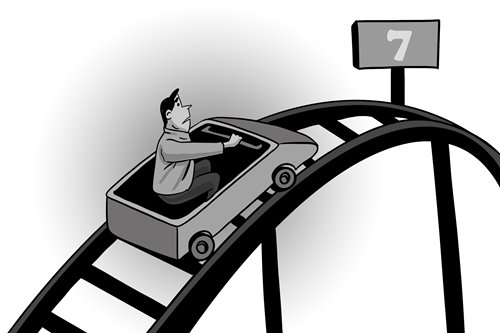HOME >> BUSINESS
The yuan’s depreciation does more harm than good
By Sheng Songcheng and Long Yu Source:Global Times Published: 2019/5/21 19:37:04

Illustration: Luo Xuan/GT
As uncertainty looms over the China-US trade row, the disadvantages will outweigh the benefits if the yuan falls 7 to 1 against the US dollar.
A 7 to 1 exchange rate is a key position that can impact market confidence. If the yuan falls, it may inspire overseas capital flight. More importantly, it will give the US a pretext during the future trade talks.
The yuan's depreciation has a very limited effect on boosting exports. And China has made it clear it will not depreciate the currency in an attempt to harm other countries.
China needs to keep in mind lessons learned from Japan's past experience - not letting the trade friction extend to financial friction. Depreciation, to some extent, is a normal market reaction to US tariff hikes on Chinese goods. But China should not induce yuan depreciation intentionally, nor should it allow significant appreciation. Maintaining the basic stability of the yuan exchange rate at a balanced level is the first best. The current economic situation and financial condition of China also lay a solid foundation for currency stabilization.
The Chinese economy so far has remained stable. The US tariff hikes will not change the economic trends. Therefore, the yuan does not have an economic basis for depreciation.
Currency depreciation brings more problems than it solves. Each country maintaining a stable exchange rate is of great significance for international trade. Stable exchange rates can reduce transaction costs within international trade and investment. They also help to expand cross-border economic activities and improve global economic stability.
For China, keeping the yuan at a balanced level would be in line with macro-level policy efforts and generate positive spillover, encouraging mutually beneficial cooperation with other nations.
Foreign investment is still increasing at a steady pace with refined structure, and maintaining a stable yuan exchange rate would be vital for such a trend.
During the first four months of 2019, foreign investors set up more than 13,000 new companies in China, and capital use reached 305 billion yuan ($44 billion), marking 6.4 percent year-on-year growth. The number means international investors are confident about China's continued development.
Confidence and financial stability are positively correlated. For instance, during the American Civil War, despite soaring prices and heavy government borrowing, people anticipated greenback appreciation. Capital poured into the US and helped address depreciation. As the Civil War ended, more long-term capital entered the US, lifting the dollar's value by 30 percent.
After many years of reform, the exchange rate for the yuan is more market-driven. Capital flow has become a major influence on the yuan exchange rate. And the exchange rate carries more asset attributes. Market expectations have also become an important factor affecting the exchange rate.
A benchmark fallout could trigger massive stop-loss transactions, which would create currency depreciation. Furthermore, those who hold a wait-and-see attitude will be tempted to enter the market to sell short and exacerbate depreciation.
Expectations are a major factor affecting the short-term exchange rate, And they are self-actualizing and tend to reinforce themselves. Once the psychological benchmark is reached, new market expectations will be re-established, most likely lower than the expected value of the yuan.
If the yuan rises above 7, it would not be in accordance with China's interests. In fact, a major yuan depreciation is not what the US wants, either. Currently, the US does not list China as a currency manipulator. For China's part, it cannot continue receiving a competitive advantage with low prices. Letting the yuan fall freely will not give enterprises incentives to improve product quality and sharpen competitiveness.
China's central bank should adhere to its prudent monetary policy, controlling the floodgates of money supply while maintaining sufficient liquidity. M2 and the aggregate financing to the real economy will have to match the nominal GDP.
A prudent monetary policy and proactive fiscal policy that are coordinated with each other will drive domestic demand. Good policy combination can benefit exports and GDP growth while avoiding an asset bubble and negative spillover effects.
In a nutshell, China's economy will still run smoothly. The country has plenty of macro-control tools and space for policy adjustments.
What China needs the most is to stay calm and keep the yuan exchange rate within a balanced range. Meanwhile, China will have to continue to improve the formation mechanism for the yuan exchange rate, letting the market run and decide resource allocation.
Sheng Songcheng is a senior adviser to the People's Bank of China and executive deputy director at China Europe International Business School (CEIBS) Lujiazui Institute of International Finance. Long Yu is a research fellow at CEIBS Lujiazui Institute of International Finance. bizopinion@globaltimes.com.cn
Posted in: INSIDER'S EYE